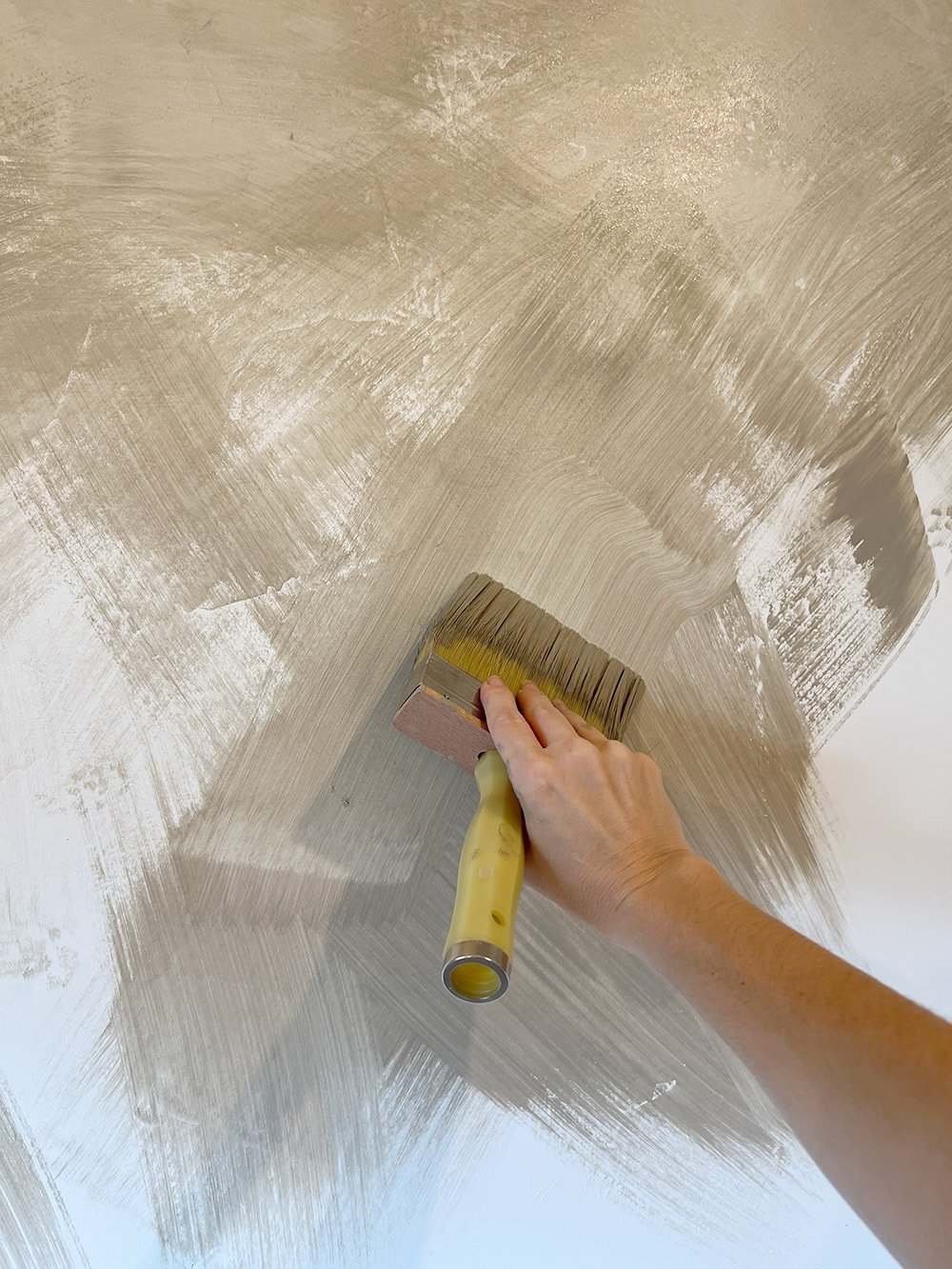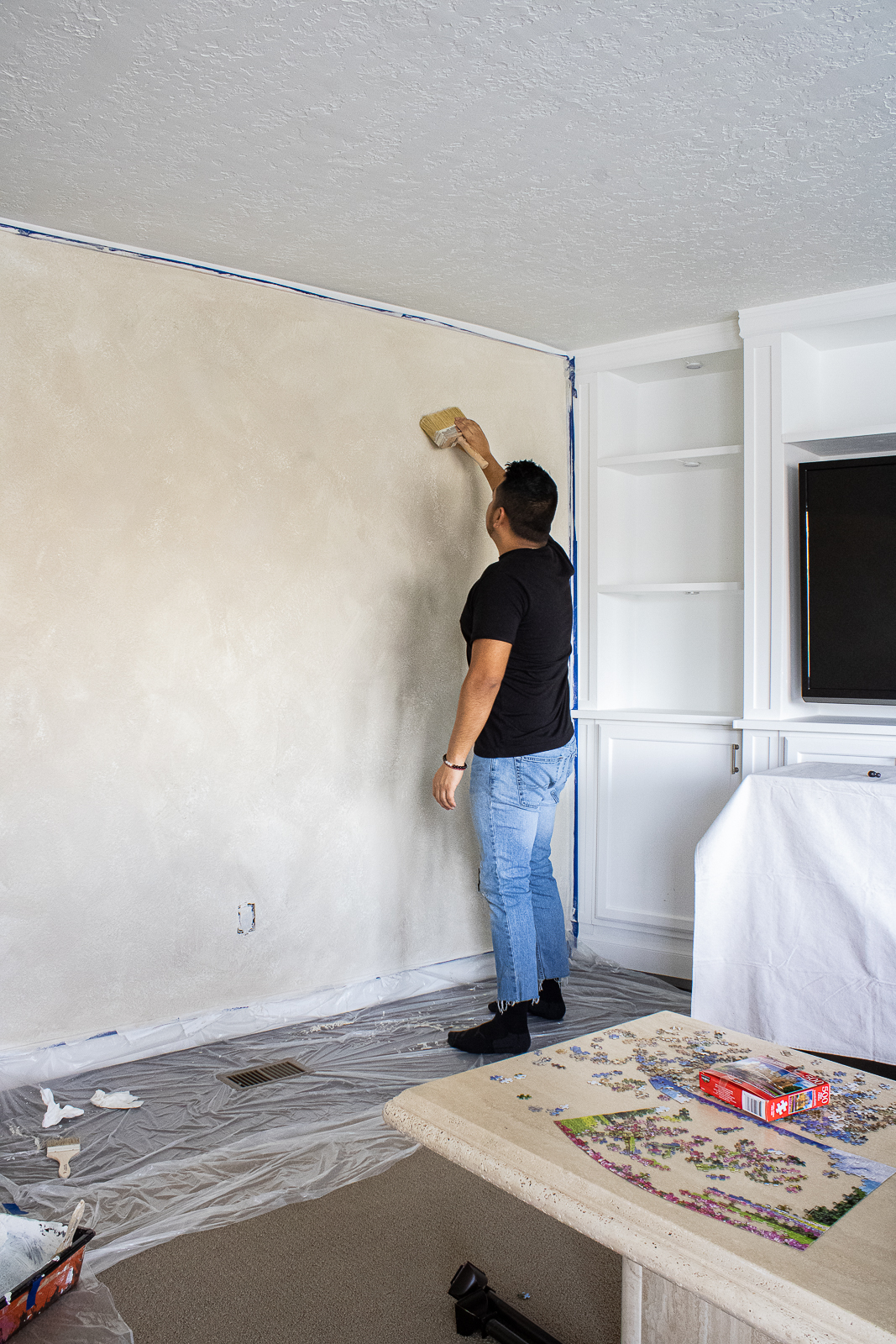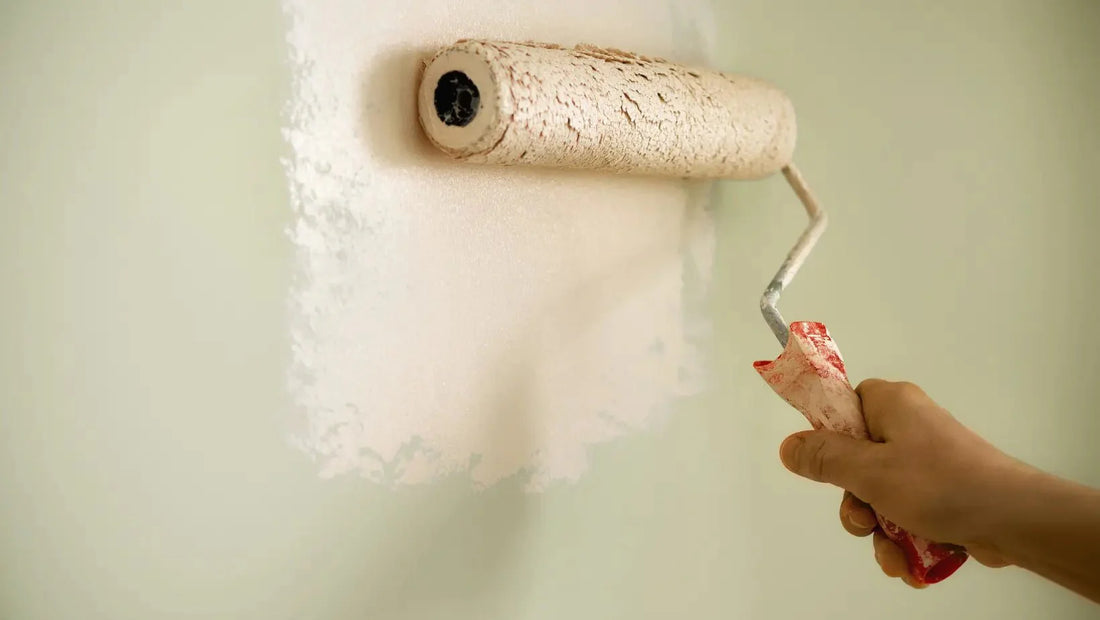Yes, you can paint over limewash. Limewash is a porous coating that allows paint to adhere to it, but proper preparation is essential for a successful outcome.
Limewash is a natural coating that has been used for thousands of years to protect and decorate buildings. It is made from a mixture of lime and water and is often used on historic buildings to give them a traditional look.
However, limewash can be difficult to remove, and many homeowners may want to paint over it to update the look of their home. We will discuss how to prepare limewash for painting and the steps to follow for a successful outcome.

Credit: www.jennasuedesign.com
Contents
Introduction To Limewash
Limewash is a traditional and eco-friendly decorative finish that has been used for centuries to add charm and character to walls. It is made from natural materials such as limestone, water, and natural pigments, offering a unique and timeless look.
Basics Of Limewash
Limewash is a breathable, mineral-based paint that forms a durable, matte finish on walls. It is well-known for its ability to create a soft, textured appearance that enhances the natural beauty of the underlying masonry. The application of limewash involves a simple process of mixing the powdered lime with water and applying it directly to the surface.
Benefits For Your Walls
- Enhances the breathability of walls
- Creates a unique, weathered patina over time
- Offers protection against mold and mildew
- Environmentally friendly and non-toxic
- Can be easily recoated or painted over
The Debate: Painting Over Limewash
Painting over limewash can be a tricky debate. While some argue that it can be done successfully, others argue that it can lead to issues with durability and adhesion. Ultimately, it depends on the specific circumstances and the preparation process.
Limewash is a popular choice for homeowners who want to give their walls a unique, rustic look. While limewash offers many benefits, some homeowners wonder if it is possible to paint over limewash. The debate over whether or not to paint over limewash has been ongoing for years. In this post, we’ll explore some common concerns and potential benefits of painting over limewash.Common Concerns
Some homeowners are concerned that painting over limewash will cause the new paint to peel or crack. Others worry that painting over limewash will ruin the unique, textured look that limewash provides. However, with proper preparation, these concerns can be minimized.Potential Benefits
Painting over limewash can provide several benefits. For one, it allows homeowners to change the color of their walls without having to remove the limewash entirely. Additionally, painting over limewash can help protect the walls from moisture and other environmental factors that can cause damage over time. If you’re considering painting over limewash, it’s important to take the time to properly prepare the walls. This may include cleaning the walls, removing any loose or flaking limewash, and applying a primer before painting. With the right preparation, painting over limewash can be a great way to update your walls while preserving the unique look that limewash provides.Preparation Steps
Yes, you can paint over limewash, but it requires careful preparation. First, remove any loose or flaking limewash with a wire brush. Next, clean the surface thoroughly and apply a coat of primer before painting with your chosen color.
Surface Evaluation
Before painting over limewash, it’s crucial to evaluate the surface to ensure it’s suitable for painting. Look for any signs of peeling, flaking, or chalking. Check for any areas of moisture damage or mold growth, as these issues need to be addressed before proceeding. Inspect the overall condition of the limewash to determine if it’s well-adhered to the surface or if there are any areas that require special attention.
Cleaning And Priming
Thorough cleaning is essential before painting over limewash. Begin by removing any dirt, dust, or debris from the surface using a stiff brush or a pressure washer. Utilize a mild detergent solution to wash the surface and ensure that it’s completely clean and free of any contaminants. Once the surface is dry, apply a suitable primer to promote adhesion and create a smooth, uniform surface for the new paint.

Credit: casarefined.com
Choosing The Right Paint
Types Of Paint To Consider
When considering painting over limewash, it’s crucial to choose the right type of paint to ensure a successful and long-lasting result. Here are some types of paint to consider:
- Acrylic Paint: Offers excellent adhesion and durability, making it a suitable choice for painting over limewash. It provides a protective layer and can withstand various weather conditions.
- Lime-Compatible Paint: Specifically designed to adhere to limewash surfaces, lime-compatible paint ensures a strong bond and prevents peeling or flaking.
- Masonry Paint: Formulated for use on mineral surfaces like limewash, masonry paint provides good coverage and protection against moisture and UV rays.
What To Avoid
While choosing the right paint is essential, it’s equally important to know what to avoid when painting over limewash. Here are some factors to consider:
- Oil-Based Paint: Avoid using oil-based paint as it may not adhere well to the limewash surface and can lead to peeling and flaking over time.
- Regular Emulsion Paint: Standard emulsion paint may not provide the necessary adhesion and durability required for painting over limewash, leading to a less resilient finish.
- Low-Quality Paint: Using low-quality paint can result in poor adhesion, uneven coverage, and a shorter lifespan for the painted surface.
Expert Tips For Application
Looking to paint over limewash? Here are some expert tips to consider. Ensure the surface is properly cleaned and prepped before applying a primer. Use a high-quality paint that is compatible with limewash and apply it evenly for a smooth and long-lasting finish.
If you’re thinking about painting over limewash, it’s important to know the best techniques for a smooth finish and how to deal with texture. Limewash is a unique paint that requires careful preparation and application to achieve the desired results. In this blog post, we’ll go over some expert tips for painting over limewash, including techniques for a smooth finish and dealing with texture.Techniques For A Smooth Finish
To achieve a smooth finish when painting over limewash, it’s important to prepare the surface properly. Start by cleaning the surface with a damp cloth to remove any dirt, debris, or loose paint. Then, use a fine-grit sandpaper to sand the surface lightly. This will help the new paint adhere better and create a smoother finish. When applying the new paint, use a high-quality brush or roller and apply the paint in thin, even coats. Allow each coat to dry completely before applying the next one. This will help you achieve a smooth, even finish without any streaks or brush marks.Dealing With Texture
If the limewash has created a textured surface, you may need to take additional steps to achieve a smooth finish. One option is to use a paint scraper or putty knife to remove any high spots or uneven areas. Another option is to use a textured paint or plaster to create a consistent texture across the surface. When using a textured paint or plaster, follow the manufacturer’s instructions carefully and test the product on a small area first. Apply the product in thin, even coats and use a trowel or roller to create the desired texture. Allow each coat to dry completely before applying additional coats. In conclusion, painting over limewash requires careful preparation and application to achieve a smooth, even finish. By following these expert tips for application, you can ensure that your paint job looks great and lasts for years to come.Long-term Care
Maintenance Tips
Regular maintenance is key to preserving the beauty and integrity of limewash painted surfaces. Here are some essential maintenance tips to keep in mind:
- Inspect the painted surface for any signs of wear and tear at least once a year.
- Clean the surface with a gentle wash using a mixture of mild soap and water, and avoid using harsh chemicals or abrasive materials.
- Address any chipping, flaking, or peeling areas promptly to prevent further damage.
- Consider applying a fresh coat of limewash every 5-7 years to maintain its vibrant appearance.
When To Repaint
Knowing when to repaint your limewashed surface is crucial for its long-term care. Here are some indicators that it’s time to consider repainting:
- Visible signs of fading, especially in areas exposed to direct sunlight.
- Noticeable damage such as cracks, chips, or peeling paint that cannot be effectively addressed through minor touch-ups.
- A change in the overall aesthetics of the limewashed surface, indicating a loss of its original charm and appeal.
Case Studies
Case studies provide valuable insights into the practical application of painting over limewash. Success stories and learning from failures offer real-life examples of the challenges and triumphs encountered when embarking on this endeavor.
Success Stories
One homeowner successfully transformed the exterior of their historic property by painting over limewash. By carefully preparing the surface and using high-quality exterior paint, they achieved a vibrant, long-lasting finish that enhanced the curb appeal of their home.
Learning From Failures
In another case, a DIY enthusiast encountered issues when attempting to paint over limewash without adequate surface preparation. The result was peeling and uneven coverage, highlighting the importance of thorough cleaning and priming before applying new paint.
Faqs
Yes, you can paint over limewash by applying a primer before painting. The primer will help the new paint adhere properly and ensure a smooth finish. It’s important to prepare the surface thoroughly for the best results.
Top Questions Answered
When it comes to painting over limewash, you may have some questions in mind. Here are the top FAQs answered to help you understand the process better:
Expert Advice
If you are considering painting over limewash, it’s important to seek expert advice to ensure the best results. Here are some recommendations from professionals:
- Prepare the surface: Before painting over limewash, make sure to thoroughly clean the surface and remove any loose or flaking paint.
- Prime the surface: Applying a primer will help create a smooth and even base for the new paint to adhere to.
- Choose the right paint: Select a paint that is suitable for the surface and desired finish. Consider factors such as durability, color, and sheen.
- Test the paint: Before applying the paint to the entire surface, it’s advisable to do a small test patch to ensure compatibility and desired results.
- Apply multiple coats: Depending on the desired coverage and finish, applying multiple coats of paint may be necessary. Allow sufficient drying time between each coat.
- Maintain the painted surface: Once the limewash has been painted over, it’s important to properly maintain the surface to ensure longevity and prevent damage.
By following these expert tips, you can achieve a successful paint job over limewash and transform the look of your space.

Credit: jamesalexanderlimewash.com
Frequently Asked Questions
Can Limewash Be Painted Over With Regular Paint?
Yes, limewash can be painted over with regular paint, but it’s important to properly prepare the surface by cleaning and priming it. Make sure the limewash is fully cured and free from any debris before applying the new paint for best results.
What Type Of Paint Is Best For Covering Limewash?
Acrylic latex paint is a great option for covering limewash. It adheres well to the surface and provides good coverage. Look for a high-quality acrylic latex paint that is specifically designed for masonry surfaces for the best results when painting over limewash.
How Should I Prepare The Limewashed Surface Before Painting?
Before painting over limewash, it’s crucial to thoroughly clean the surface to remove any dirt, dust, or debris. Additionally, applying a suitable primer designed for masonry surfaces will help ensure proper adhesion and a smooth, long-lasting finish.
Can I Change The Color Of Limewash By Painting Over It?
Yes, you can change the color of limewash by painting over it with a different color. However, it’s important to choose a paint color that is compatible with the limewash and to properly prepare the surface to ensure the new color adheres effectively for a beautiful, lasting finish.
Conclusion
To conclude, painting over limewash is indeed possible, but it requires proper preparation and consideration. By following the necessary steps, such as cleaning, priming, and using the right type of paint, you can achieve a successful result. Remember to consult with professionals or do thorough research to ensure the best outcome for your project.
With careful planning and execution, you can transform your limewashed surfaces to suit your desired aesthetic. Happy painting!
